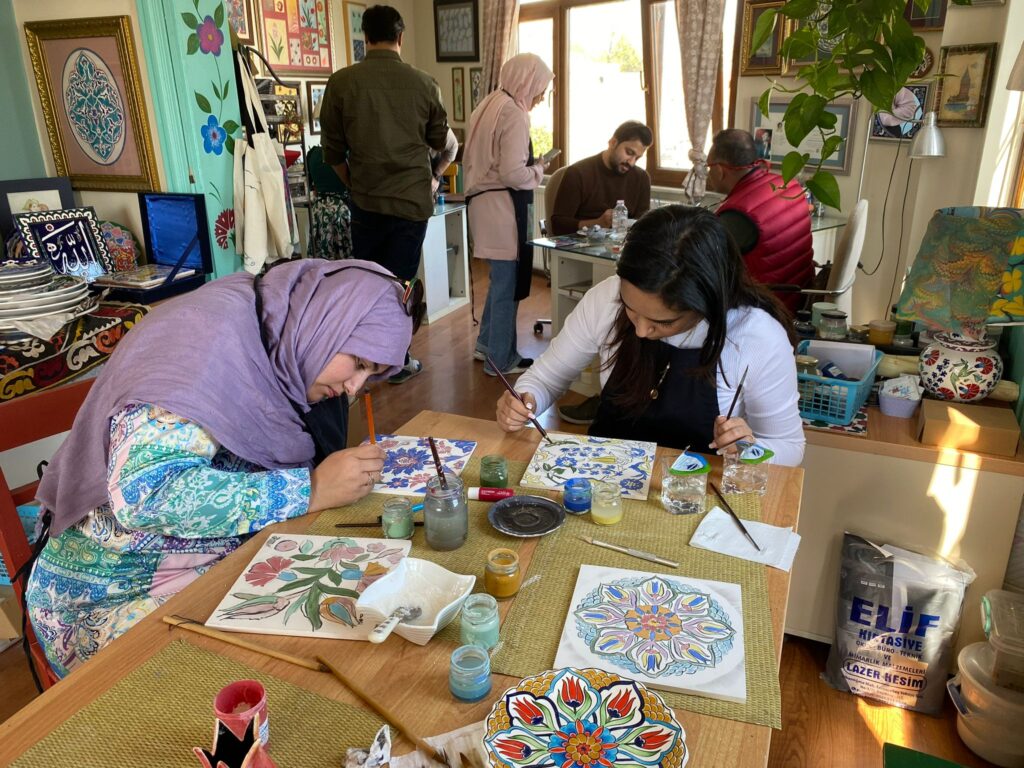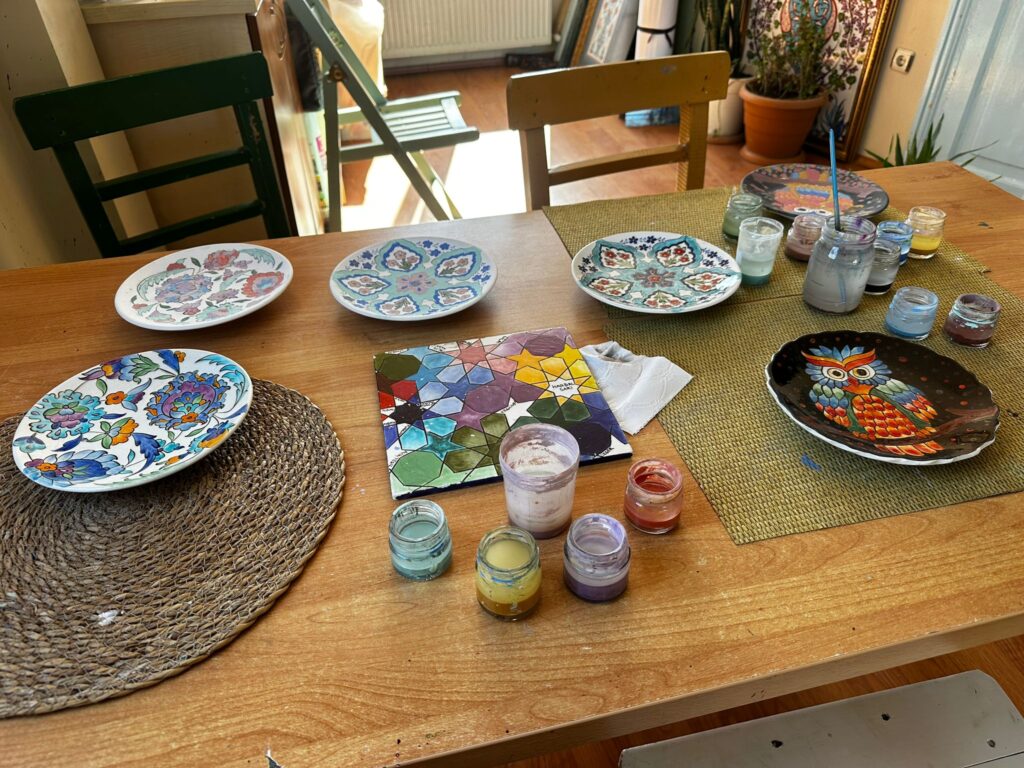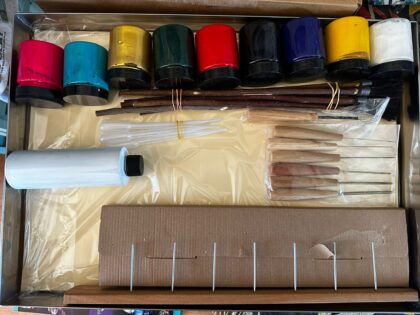Turkish Tile ( Cini ) Painting Workshops in Sultanahmet Istanbul
Private or Group Classes Available All Year Long — Traditional Turkish Tiles
The art of Turkish tiles and ceramics is very important in the history of Islamic art. Its roots can be traced at least as far back as the Uighurs of the 8th and 9th centuries. Its subsequent development was influenced by Karakhanid, Ghaznavid, and (especially) Iranian Seljuk art. With the Seljuks’ victory over the Byzantines at Malazgirt in 1071, the art followed them into Anatolia and embarked upon a new period of strong development fostered by the Anatolian Seljuk sultanate.
There is a widely held but quite erroneous belief that figurative painting is not found in Islamic art due to prohibition by the Koran. Religious rulings issued only in the ninth century discouraged the representation of any living beings capable of movement but they were not rigidly enforced until the fifteenth century. Figural art is especially rich in tiles as well as stone and stucco reliefs of the Seljuk period, adorning both secular and religious reliefs monuments. The subjects included nobility as well as servants, hunters and hunting animals, trees, birds, sphinxes, lions, sirens, dragons, and double-headed eagles.

The art of Turkish tile and ceramic-making developed over the centuries incorporating many different techniques and styles. Enriched by the arrival of the Seljuks, the ceramic industry in Anatolia achieved a deservedly worldwide reputation with the support of the Ottoman court. Today, Kutahya has been revived as an important center of tile and ceramic-making. In addition, efforts are also being made in private workshops and educational institutions in Iznik, Istanbul, and Bursa to keep the art of traditional Turkish tiles and ceramics alive and develop it so that it can address the demands of modern-day life.

Our Workshops :
We have an Art Studio in the Sultanahmet area and our local teachers are professionals in Traditional Turkish Tile & Ceramics workshops. In our place, we give beginner, intermediate & advanced levels of traditional Turkish Tile & Ceramic painting lessons. Usually, lessons are 2 hours, and by the end of 2 hours, you will be able to finish one item like a tile, plate, or figure. ( Depending on the design, lessons can be longer as well )

In our studio, we provide all the materials for our students.
We also have the Tile Owen to finish the process.
( The price is for the lesson. We fire our Kiln once or twice in a kiln.
If you have time, we will fire your tiles and give you the ready product or we can ship it to you if you can pay the shipping cost. )

Group Lessons for High Schools and Universities can be provided All Year Long.
Please send us an e-mail if you are interested in participating in our classes as an individual or a student group.
In Our Studio, you can visit us and see & purchase our artwork.

RECOMMENDED ART AND CULTURAL TOURS IN ISTANBUL ;
EBRU LESSON WORKSHOP IN SULTANAHMET ISTANBUL
TURKISH MARBLING EBRU SET AND MATERIALS ISTANBUL
TURKISH TILE PAINTING LESSON IN SULTANAHMET ISTANBUL
TURKISH HENNA LESSON IN SULTANAHMET ISTANBUL
TURKISH FELT MAKING LESSON IN SULTANAHMET ISTANBUL
CALLIGRAPHY LESSON IN ISTANBUL
HAND MADE BOOK BINDING LESSON IN SULTANAHMET ISTANBUL
TURKISH COOKING LESSON IN ISTANBUL
TURKISH MUSICAL INSTRUMENTS IN ISTANBUL
HOME MADE BAKLAVA LESSON IN ISTANBUL
Contact : Hakan HACIBEKIROGLU
Facebook: https://www.facebook.com/hakanhacibekiroglu
Instagram: https://www.instagram.com/hakanhacibekir/
Twitter : https://twitter.com/hakanhacibekir
Whatsapp: +905337385862
E-mail : hakan_hacibekiroglu@yahoo.com ( 24/7 Online )
History of Turkish Tiles & Ceramics
In an Ottoman tile making workshop, students can learn various techniques for creating these beautiful ceramic tiles. These techniques may include:
- Clay Preparation: Students learn how to prepare the clay, including mixing it to the right consistency and kneading it to remove air bubbles.
- Tile Shaping: Techniques for shaping the clay into tiles of various shapes and sizes are taught. This may involve hand-building techniques such as coiling, slab-building, or using molds.
- Design and Decoration: Students learn how to create intricate designs and patterns using traditional Ottoman motifs. This may involve techniques such as carving, incising, or painting with underglazes and glazes.
- Firing: The process of firing the ceramic tiles is a crucial step in Ottoman tile making. Students learn about different firing techniques, temperatures, and kiln types to achieve the desired results.
- Glazing: Techniques for applying glazes to the tiles, including dipping, brushing, or spraying, are taught. Glazes are essential for adding color and protecting the tiles’ surface.
- Finishing: After firing, students learn how to finish the tiles by sanding, polishing, or adding decorative elements such as metallic lustres.

Ottoman tile making workshops play a vital role in preserving and promoting Turkey’s cultural heritage. They provide a space for both locals and tourists to learn about traditional ceramic arts and engage in creative expression. Additionally, these workshops contribute to the economy by attracting visitors interested in experiencing Turkish culture firsthand and purchasing locally-made artwork.
Overall, Ottoman tile making workshops serve as hubs of creativity, education, and cultural exchange, keeping alive a centuries-old tradition while also inspiring contemporary artistic endeavors.











Reviews
There are no reviews yet.